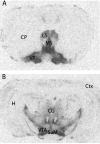Vasopressin: behavioral roles of an "original" neuropeptide
- PMID: 18053631
- PMCID: PMC2292122
- DOI: 10.1016/j.pneurobio.2007.10.007
Vasopressin: behavioral roles of an "original" neuropeptide
Abstract
Vasopressin (Avp) is mainly synthesized in the magnocellular cells of the hypothalamic supraoptic (SON) and paraventricular nuclei (PVN) whose axons project to the posterior pituitary. Avp is then released into the blood stream upon appropriate stimulation (e.g., hemorrhage or dehydration) to act at the kidneys and blood vessels. The brain also contains several populations of smaller, parvocellular neurons whose projections remain within the brain. These populations are located within the PVN, bed nucleus of the stria terminalis (BNST), medial amygdala (MeA) and suprachiasmatic nucleus (SCN). Since the 1950s, research examining the roles of Avp in the brain and periphery has intensified. The development of specific agonists and antagonists for Avp receptors has allowed for a better elucidation of its contributions to physiology and behavior. Anatomical, pharmacological and transgenic, including "knockout," animal studies have implicated Avp in the regulation of various social behaviors across species. Avp plays a prominent role in the regulation of aggression, generally of facilitating or promoting it. Affiliation and certain aspects of pair-bonding are also influenced by Avp. Memory, one of the first brain functions of Avp that was investigated, has been implicated especially strongly in social recognition. The roles of Avp in stress, anxiety, and depressive states are areas of active exploration. In this review, we concentrate on the scientific progress that has been made in understanding the role of Avp in regulating these and other behaviors across species. We also discuss the implications for human behavior.
Figures





References
-
- Aarde SM, Jentsch JD. Haploinsufficiency of the arginine-vasopressin gene is associated with poor spatial working memory performance in rats. Horm Behav. 2006;49:501–508. - PubMed
-
- Acher R. Structure evolution and processing adaptation of neurohypophysial hormone-neurophysin precursors. Prog Clin Biol Res. 1990;342:1–9. - PubMed
-
- Aguilera G, Pham Q, Rabadan-Diehl C. Regulation of pituitary vasopressin receptors during chronic stress: relationship to corticotroph responsiveness. J Neuroendocrinol. 1994;6:299–304. - PubMed
-
- Aguilera G, Rabadan-Diehl C. Regulation of vasopressin V1b receptors in the anterior pituitary gland of the rat. Exp Physiol. 2000a;85:19S–26S. Spec No. - PubMed
-
- Aguilera G, Rabadan-Diehl C. Vasopressinergic regulation of the hypothalamic-pituitary-adrenal axis: implications for stress adaptation. Regul Pept. 2000b;96:23–29. - PubMed
Publication types
MeSH terms
Substances
Grants and funding
LinkOut - more resources
Full Text Sources
Other Literature Sources
Miscellaneous

